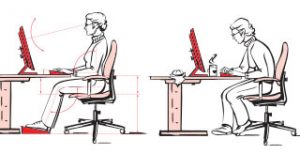- New Patient Line:
- (907) 336-0200
 Chronic pain is a cruel task-master.
Chronic pain is a cruel task-master.
Day in and day out it drives you–to find a remedy, a procedure, an exercise, pill, potion or lotion–to find anything that will make it go away. And all that searching is exhausting: between appointments with doctors and specialist, blood tests, MRI’s, CAT scans and X-rays, chronic pain often leaves individuals not only physically drained, but mentally and emotionally as well.
When I see people who continue to deal with the same chronic pain, despite having gone through multiple surgeries and painful injections, and can’t afford to live life doped up on narcotics to dull their pain, they’re often at a point where the mental and emotional stress of dealing with their pain is almost worse than the pain itself. In those situations, when we find that correcting their atlas provides the relief they’ve been desperately trying to find, sometimes for years, they inevitably ask a version of this one question: “Why didn’t any of my other doctors see this and tell me that it could be the problem?”
It’s actually a very good question. Usually these individuals have had scores of X-rays, MRI’s and other images done–many of which look at the same area that I look at when determining the proper course of action. But they’ve never been told of any problem with the upper-cervical spine that might be contributing to or causing their pain. What’s not usually understood is the fact that a medical specialist and a NUCCA practitioner are looking at the same situation from two very different perspectives.
How’s that? To quote a review article concerning pain involving the upper-cervical spine from a medical journal entitled Pain Physician: “They are frequently underdiagnosed since there is typically no X-ray or computerized tomographic scanning or magnetic resonance imaging wherein gross structural abnormality is evident.” By far, the majority of medical specialists are going to be looking in the upper cervical spine for “gross structural abnormality” when looking for the cause of chronic pain. That means they’re looking for something big and obvious, and if they don’t see it they’re going to say that the X-ray or MRI or CAT scan is “unremarkable” or normal.
The difference is that what may appear unremarkable to the medical specialist may prove quite remarkable to the NUCCA specialist. Why? Because from an upper-cervical chiropractic standpoint that’s exactly what we’re looking for. We know that small changes in the relationship or alignment between the head and the upper two vertebrae in the neck can affect the central nervous system and cause both acute and chronic pain syndromes.
The medical community is very good at dealing with emergency and crisis care situations–situations when “gross structural abnormality” may be present. However, in the absence of such findings it’s critical that individuals dealing with chronic pain be carefully evaluated by an upper-cervical chiropractor according to NUCCA protocols. As a safe, non-invasive procedure, NUCCA has the potential to help individuals avoid costly, unnecessary, and potentially harmful procedures when the cause of their pain is related to specific upper-cervical alignment.

